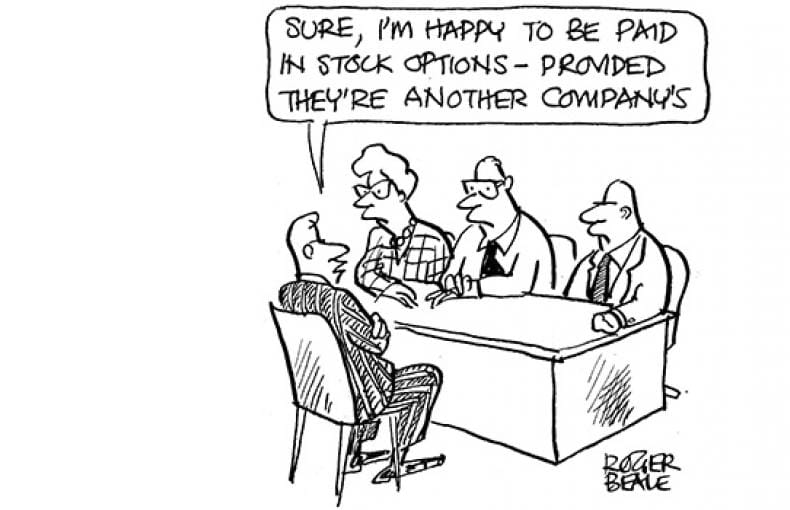
Stock-options grants are tied to executives' risk-taking and increased leverage.
- By
- June 20, 2014
- CBR - Summer 2014

Stock-options grants are tied to executives' risk-taking and increased leverage.
It has become conventional wisdom that big stock-options grants cause CEOs to take big risks. The US-government sponsored Financial Crisis Inquiry Commission (FCIC), in a 2011 report, blamed stock-options grants for contributing to the 2007–10 financial crisis, concluding that "these pay structures had the unintended consequence of creating incentives to increase both risk and leverage."
Despite the FCIC's statement, the evidence to support its claim has been light. But research by Chicago Booth Assistant Professor Kelly Shue, with Richard R. Townsend of Dartmouth College's Tuck School of Business, produces empirical evidence that ties stock-options grants to executives' risk-taking and increased leverage. The researchers find that such grants encourage executives to take on more risk and debt, but not to the extent the popular narrative suggests.
The argument for paying a CEO with stock options is that it gives the executive an incentive to increase value for shareholders. If the CEO drives up the underlying stock price, the options award will be worth more. The problem is that a CEO may take excessive risks to drive up the share price. While that might increase the CEO's compensation, he or she won't necessarily share other shareholders' pain if the stock loses value. Options exhibit "convexity," which means options granted to CEOs have a potentially unlimited upside, while the downside is limited to zero if the stock doesn't rise to the predetermined price.
Shue and Townsend write that researchers in the past found a positive relationship between options and risk-taking, but "the magnitudes vary from large to near-zero." More important, prior research linking options to risk-taking failed to control for other factors, such as changes in the business environment, which means any relationship identified might not be causal.
Shue and Townsend sought to identify a causal effect—to measure the direction and magnitude of the effect of options on risk-taking—through a natural experiment involving typical compensation plans that grant options.
The experiment compared the performance of companies that grant a defined number of options with the performance of those that award options worth a defined amount. In the former, the value of the grant has the potential to rise and fall with market movement. In the latter, the value is fixed over a two- to three-year period. That difference provides the authors with a control group for their study.
The experiment also takes advantage of the fact that companies typically grant options on a regular schedule with large raises once every two or three years. The timing of these raises is staggered across firms, which allows the authors to compare the behavior of executives who received a raise in a certain year with the behavior of their peers who received pay bumps in earlier years. The researchers compiled their dataset using the plans in place for companies from 1984 to 2010.
Shue and Townsend find that stock-options grants have a positive but moderate effect on risk-taking. A 10% increase in the value of new options granted led to a 2%–6% increase in the volatility of a company’s stock price, which is the researchers’ measure of risk. This increase in volatility is primarily driven by increased use of debt.
“We also find that an increase in stock options leads to lower dividend growth, with mixed effects on investment and firm performance,” the researchers write.
The effect of options awards on risk-taking is greater in the financial and technology sectors. This may be because executives have more ability to take on risk by using derivatives and pursuing products that are riskier to develop.
The findings suggest that, overall, executives take a moderate amount of risk when compensated with options—which Shue and Townsend point out may be an effective way to encourage risk-averse executives to take bigger gambles and to gain tax benefits from increased debt. “Moderate increases in options may be an effective way to encourage executives to increase risk-taking,” they write.
If a company’s board of directors wants its CEO to take on more risk or leverage, increasing stock-options awards is an appropriate strategy, says Shue. However, if the board does not want its CEO to take on additional risk, it should be aware that stock options lead to greater risk-taking.

Kelly Shue and Richard R. Townsend, "Swinging for the Fences: Executive Reactions to Quasi-Random Options Grants," Working paper, February 2014.
Your Privacy
We want to demonstrate our commitment to your privacy. Please review Chicago Booth's privacy notice, which provides information explaining how and why we collect particular information when you visit our website.